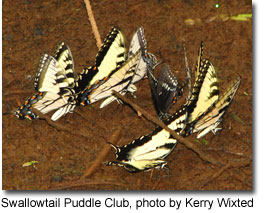
Water is essential for life, and one of the best ways to attract wildlife to your backyard is to add a water source. Many animals, like frogs, can actually sense water. So, as the infamous saying goes, if you build it, they will come.
One of the simplest ways of providing water for wildlife is to have a bird bath. Bird baths should be placed out in the open, at least 15 feet away from windows and dense cover. By placing baths near dense cover, you run the risk of predators hiding in the cover. Raised bird baths are good for areas where cats may roam. However, some birds will also use bird baths placed on the ground. Make sure all bird baths have a gentle incline and depth not more than 2 to 3 inches. Be sure to change the water in the bath every 2-3 days, especially during mosquito breeding season.
Adding noise to your bird bath can also attract additional wildlife. The easiest way to add the sound of water to your bird bath is to attach a dripping hose along an overhanging branch. Another method is the dripping pail. Poke a nail hole through the bottom of a bucket and then thread a short cotton rope or a small piece of cotton cloth through the hole to serve as a wick. Hang the bucket over your bird bath and fill it daily with water. If your bird bath is large enough, then you can also consider adding a small fountain to it.

A simple terra cotta saucer can also provide a water source for wildlife. To attract butterflies, take a shallow saucer and fill it with sand. Cover the sand with a small amount of water and place it in a sunny location near plants that butterflies frequent. Oftentimes, butterflies will form “puddle clubs” in saucers or in puddles along dirt roads and paths. The latter areas tend to have concentrated nutrients from accumulation and evaporation of water over time. Butterflies will even visit these sites after the puddles have dried up. Butterflies secrete saliva through their proboscis and then suck up the nutrients. Interestingly, most butterflies at puddle clubs are males which are attracted to sodium and other nutrients needed for mating. Males pass the nutrients to their mates through the spermatophore during mating. Terra cotta saucers can also be placed in shaded areas for amphibians like toads and salamanders.
Rain gardens are another way to provide water for wildlife while also reducing run-off. Rain gardens are best placed in low-lying areas at least 10 feet away from your downspout. The rain garden should also be placed 35 feet or more from septic system drain fields, 50 feet or more from drinking water wells and well away from utility lines. Rain gardens can be any shape or size depending on your lot and your needs. Rain gardens should only be about 4-10 inches deep in order to collect water and then allow it to infiltrate into the ground. Be sure to plant native plants in and around your rain gardens that can withstand moist to wet conditions.

If you have the time and the space, then a backyard pond is a great addition for wildlife. Ponds can come in any shape or size, depending on your preferences and area. All ponds should have some vegetation around them for cover, though. By planting native plants in and around your pond, you will attract native insects which are food for birds, amphibians, reptiles and mammals. Animals that might be attracted to your garden pond include dragonflies, turtles, frogs, birds, snakes, lizards and raccoons.
Adding koi or other fish to your pond will prevent dragonflies and amphibians from using the area as these fish eat dragonfly nymphs as well as amphibian eggs. Don’t use chemicals in and around your pond. If mosquitoes are breeding in your pond, then use
Bacillus thuringiensis var. iseaeliensis (10%) which is commonly sold as floating dunks that can be placed in the pond. Most wildlife ponds will not need a pump. However, if you do choose to have a pump and filtration system then be sure it is covered with a very fine mesh to prevent it from sucking up and killing tadpoles.
A few stones in and around your pond can also provide great habitat, but try to avoid large, flat pavers as sometimes frogs can stick to them and dehydrate. For more information on backyard ponds,
check out the Wild Acres article.
All in all, no matter what you do to add water to your backyard landscape, the water will benefit a variety of wildlife.
Invite Wildlife to Your Backyard!
For Additional Information, Contact:
Sarah Witcher
Wildlife and Heritage Service
580 Taylor Ave, E-1
Annapolis, MD 21401
sarah.witcher1@maryland.gov
Phone: 410-260-8566
Acknowledgements:
- Common grackle enjoys a bath, photo by George Jett
- Swallowtail Puddle Club, photo by Kerry Wixted
- Eastern pondhawk dragonfly, photo by Kerry Wixted